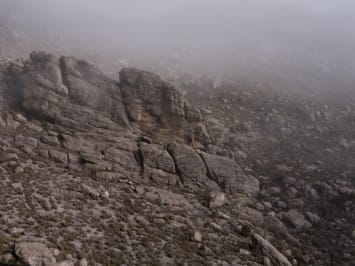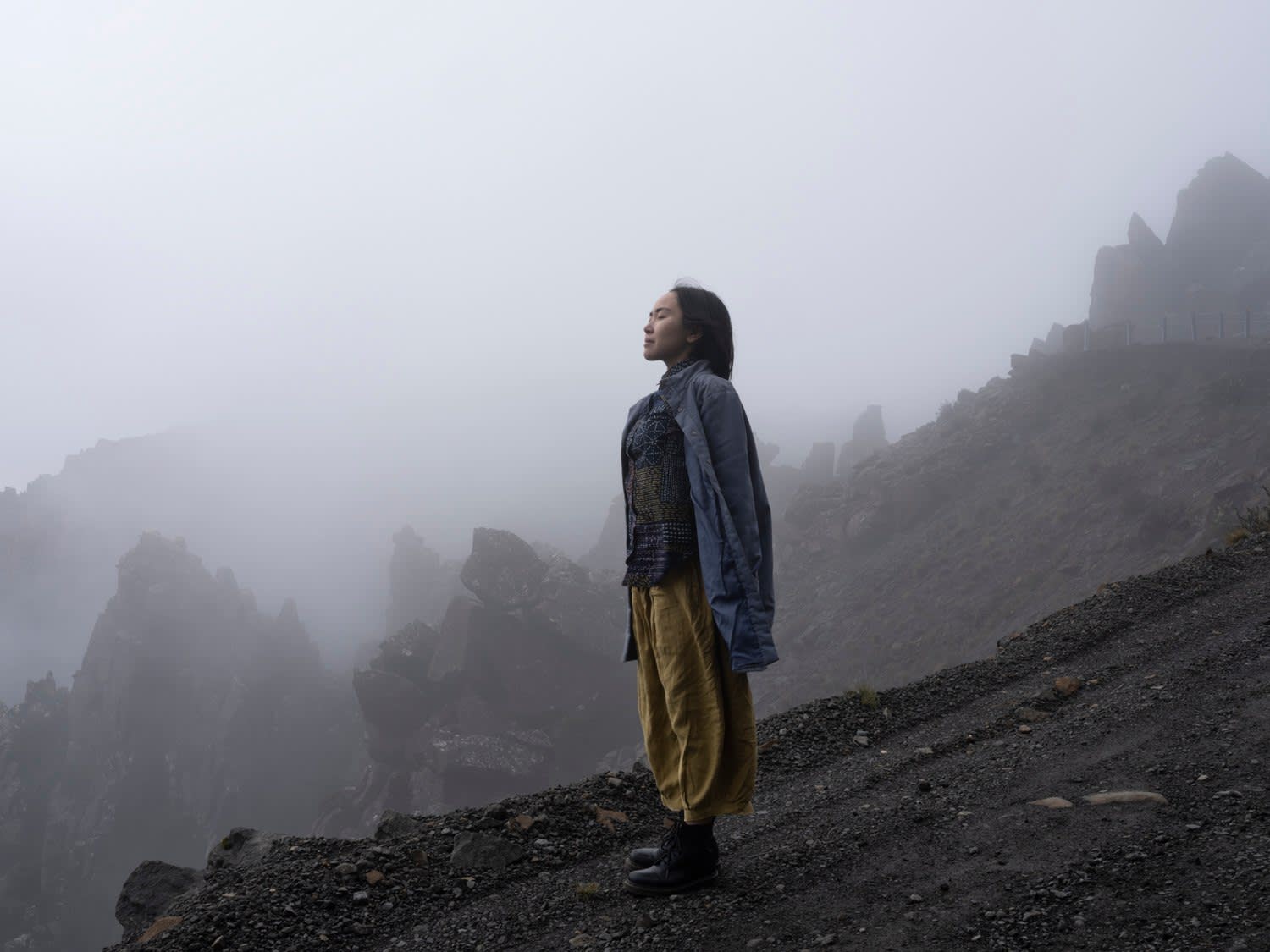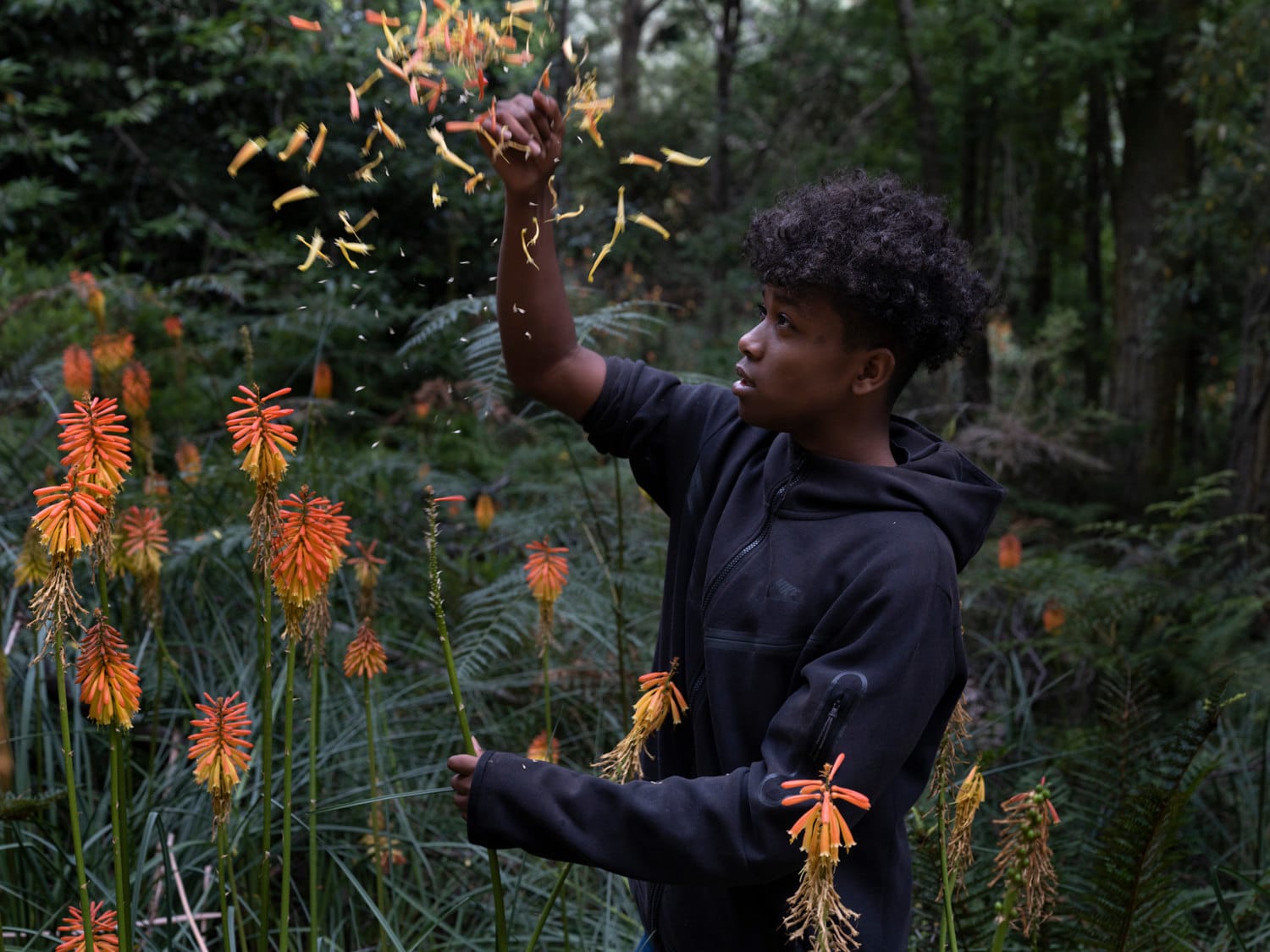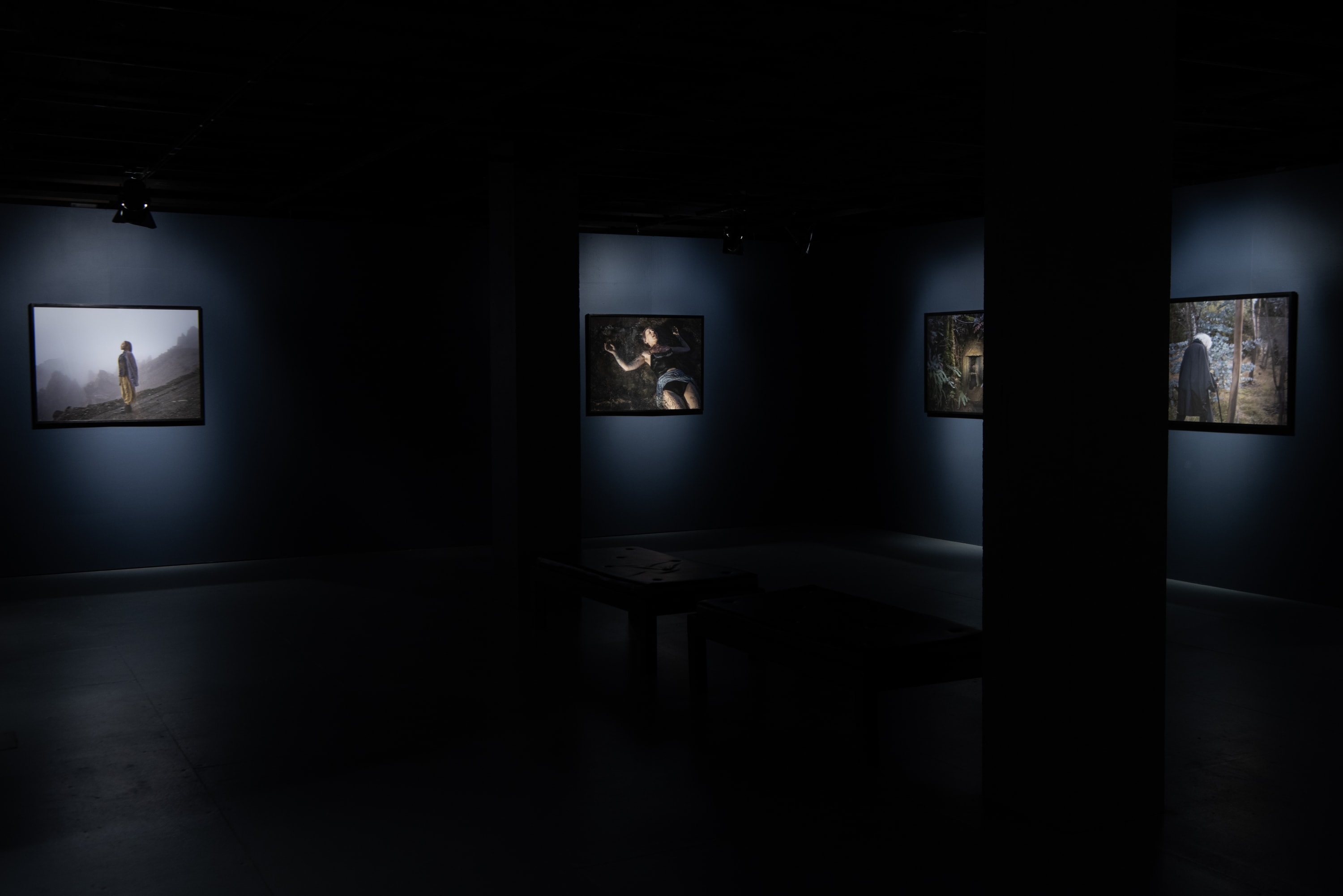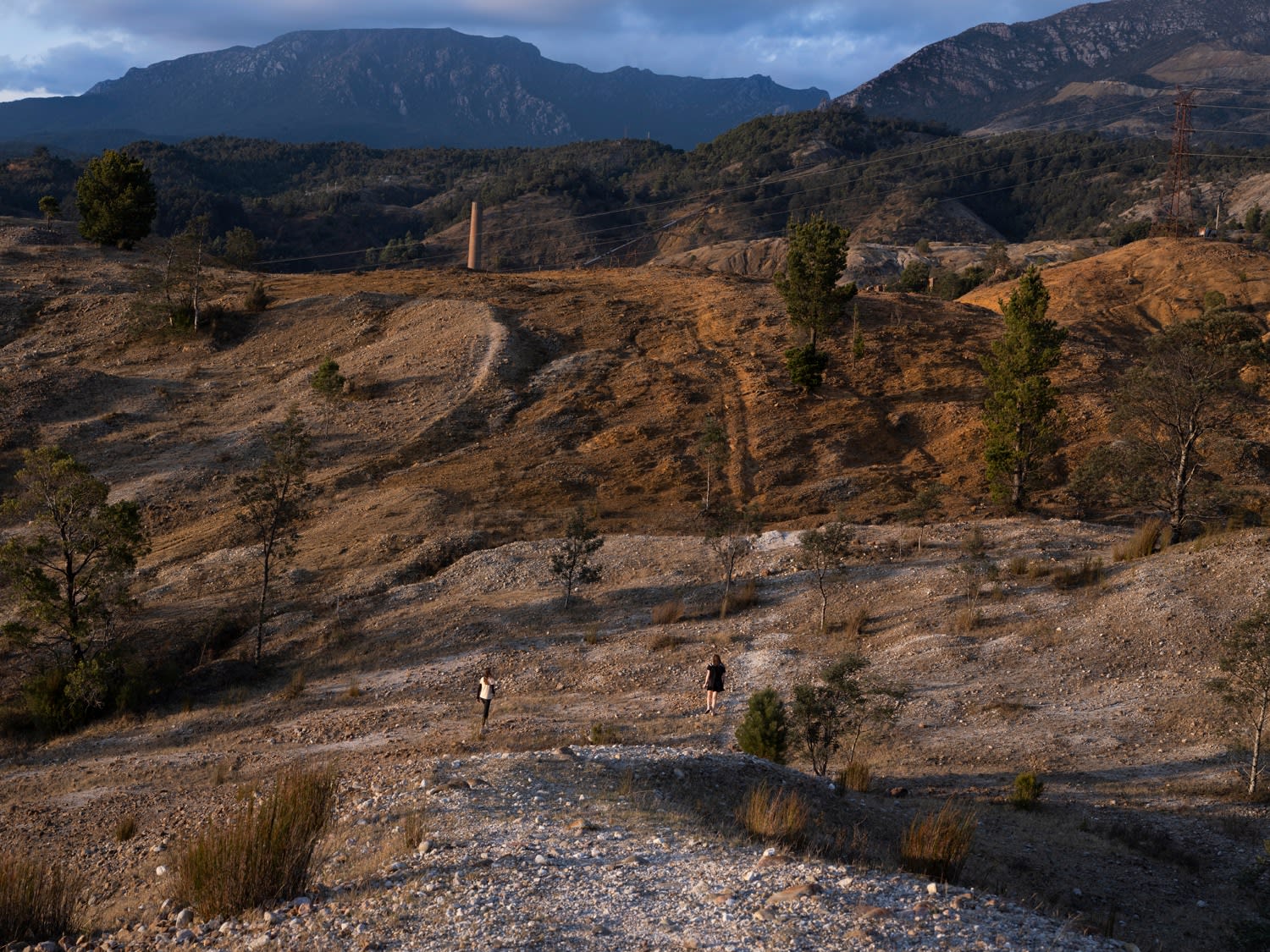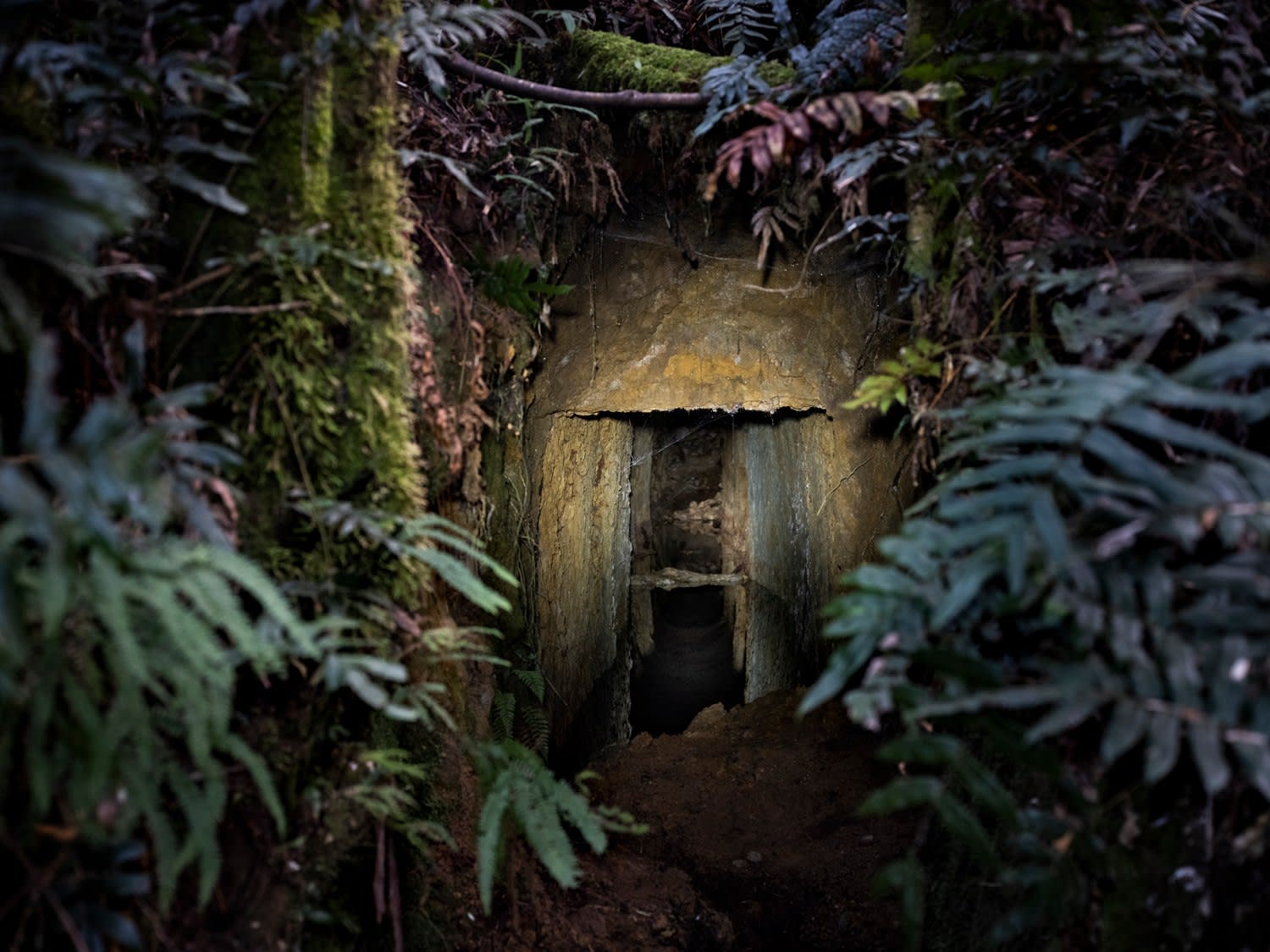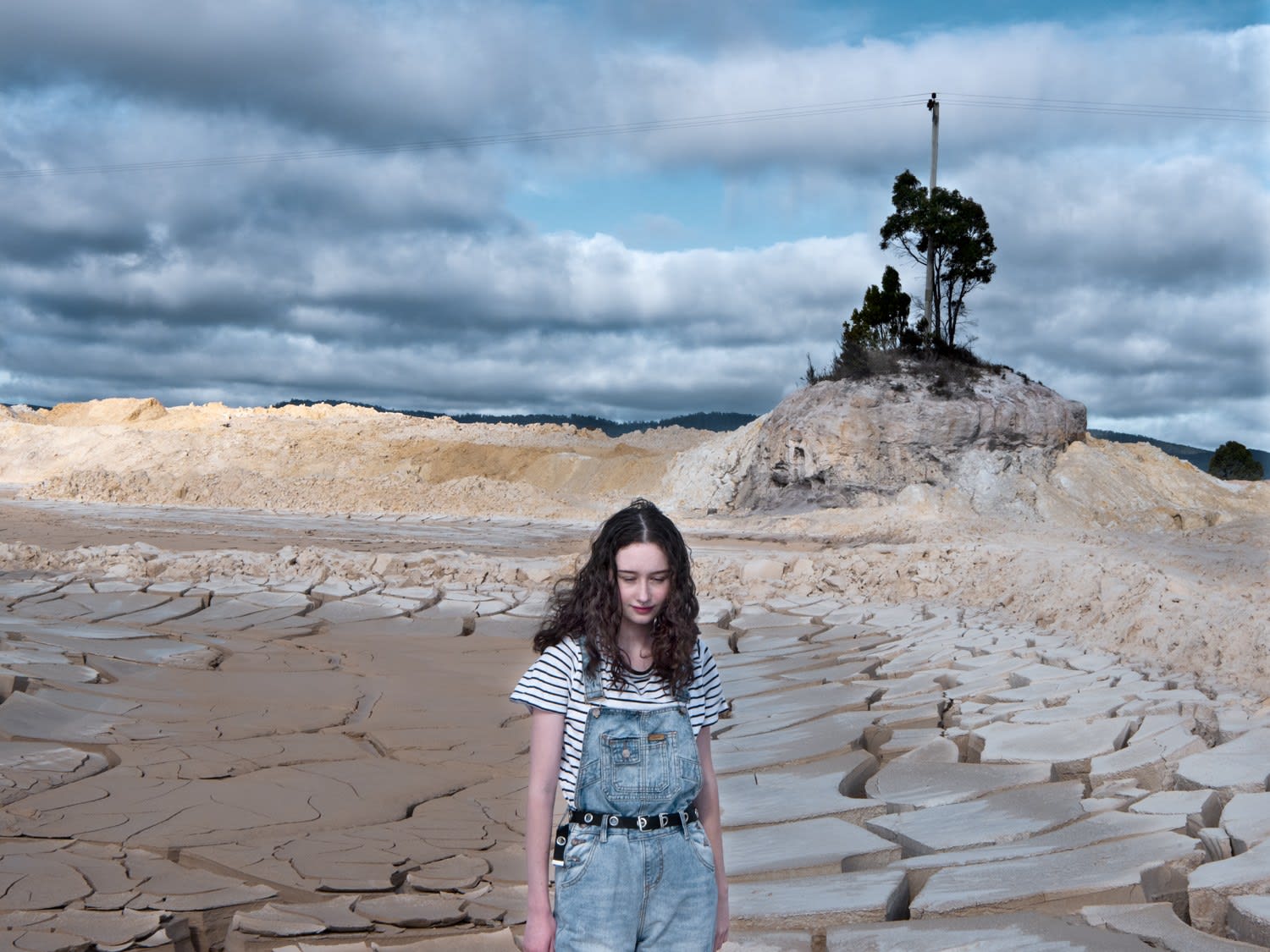Stories and islands reflect and implicate one another. Islands inspire stories, contain and preserve stories, carry their own forms of condensed narration and articulation. Stories are like islands, apart from a larger web of narration, and yet also belonging to it, together they form parts of larger archipelagos, and like islands they rise up into the sea of the world like markers and signs of our journeying.
-
 Sarah RhodesMinami, 2022pigment print on cotton rag paper60 x 80cm (paper size)
Sarah RhodesMinami, 2022pigment print on cotton rag paper60 x 80cm (paper size)
edition of 5 plus 2 artist's proofs
AU$ 2,400.00 + framing
90 x 120 cm (paper size)
edition of 5 plus 2 artist's proofs
AU$ 3,400.00 + framing... In their unfolding stories and islands are in a constant state of poesis - a continual state of becoming. Every island and every story is experienced from the perspective of one's own life experience - each one involving a different weave of place and narrative and each one offering a renewed entry into and vision of the world.
-
Our interaction with the island that is lutruwita/Tasmania and its people, and so too with the stories that belong to both, we are able to arrive at a deepened understanding of what it means to be somewhere, to be connected to place, and part of society. Island and story – and especially the island stories of lutruwita/Tasmania permeate my work...
- Sarah Rhodes
-
-
 Sarah RhodesBlow, 2020pigment print on cotton rag paper80 x 60cm (paper size)
Sarah RhodesBlow, 2020pigment print on cotton rag paper80 x 60cm (paper size)
edition of 5 plus 2 artist's proofs
AU$ 2,400.00 + framing
120 x 90 cm (paper size)
edition of 5 plus 2 artist's proofs
AU$ 3,400.00 + framing -
 Sarah RhodesColleen, 2022pigment print on cotton rag paper60 x 80cm (paper size)
Sarah RhodesColleen, 2022pigment print on cotton rag paper60 x 80cm (paper size)
edition of 5 plus 2 artist's proofs
AU$ 2,400.00 + framing
90 x 120 cm (paper size)
edition of 5 plus 2 artist's proofs
AU$ 3,400.00 + framing
-
-
Full of the colours and textures of earth and rock, of cloud and mist, of water and ice, of branch, grass, and leaf, these images show the interweaving of personal existence - existence as felt, as remembered, as imagined, as thought - with the dense materiality of the world...
- Jeff Malpas
-

Sarah Rhodes
Ice Waterfall 1, II, III, 2022pigment print on cotton rag paper
triptych: 80 x 60cm (individual size) 80 x 180 cm (approx. overall size)
edition of 5 plus 2 artist's proofs
AUD$ 6,000.00 + framing
triptych: 90 x 120 cm (individual size) 90 x 360 cm (approx. overall size)
edition of 5 plus 2 artist's proofs
AUD$ 8,500.00 + framing
-

-
Many of these photographs show places that are marked and scarred, bearing the vestigial traces of past activity; places that are abandoned and remote, their histories buried and perhaps forgotten...
- Jeff Malpas
-

Sarah Rhodes
Isobelle and Teyah, 2022pigment print on cotton rag paper
60 x 80cm (paper size)
edition of 5 plus 2 artist's proofs
AU$ 2,400.00 + framing
90 x 120 cm (paper size)
edition of 5 plus 2 artist's proofs
AU$ 3,400.00 + framing -
In her portraits of people and places, Rhodes does not merely show us individuals in landscapes. Instead, we are shown the place and the person at one and the same time; in the place we see the inner, both of place and person; in the place, we glimpse the soul – and not only of those pictured, but also, perhaps, our own...
- Jeff Malpas
-
-
 Sarah RhodesScott, 2022pigment print on cotton rag paper60 x 80cm (paper size)
Sarah RhodesScott, 2022pigment print on cotton rag paper60 x 80cm (paper size)
edition of 5 plus 2 artist's proofs
AU$ 2,400.00 + framing
90 x 120 cm (paper size)
edition of 5 plus 2 artist's proofs
AU$ 3,400.00 + framing -
 Sarah RhodesRobyn, 2021pigment print on cotton rag paper60 x 80cm (paper size)
Sarah RhodesRobyn, 2021pigment print on cotton rag paper60 x 80cm (paper size)
edition of 5 plus 2 artist's proofs
AU$ 2,400.00 + framing
90 x 120 cm (paper size)
edition of 5 plus 2 artist's proofs
AU$ 3,400.00 + framing
-
-

A Surrounded Beauty aims to convey how entwined people are with place...
- Sarah Rhodes
-

Sarah Rhodes
Hosana , 2020pigment print on cotton rag paper
60 x 80cm (paper size)
edition of 5 plus 2 artist's proofs
AU$ 2,400.00 + framing
90 x 120 cm (paper size)
edition of 5 plus 2 artist's proofs
AU$ 3,400.00 + framing -
In a recent film on sites in London associated with the Swedish visionary and religious thinker, Emmanuel Swedenborg, the writers Stephen McNeilly and Ian Sinclair talk about the Swedenborgian idea that, as McNeilly puts it, ‘place is an inner sense.’ The idea, which can be variously understood (it is tied, in Swedenborg’s own thinking, to his ‘theory of correspondences’ in which the spiritual and earthly are united), has had an influence on many strands of thought, from Blake to Baudelaire, Schönberg to Suzuki, and especially on contemporary ‘psychogeography’. The latter term comes originally from the work of the French situationists, although it has also been taken up by English writers such as Sinclair. It refers, in its contemporary context, to a way of understanding the psychical and the geographic as intimately bound together. The ‘inner’ and the ‘outer’ are thus not apart from one another: place is the inner, and the inner is always placed.
I happened to watch McNeilly and Sinclair on Swedenborg just as starting the writing for this exhibition. I already knew Rhodes’ work very well and was also familiar with its focus on the photographic portrait. It is common to understand such portraits as about, not just about the external appearance of the subject, but also about what is internal to them, and so as indeed about the ‘inner’, although most often taken in terms of aspects of their character, personality, or perhaps of their lived biography.
When I returned to look again at the entire body of images Rhodes has created over the last five years or so (essentially the images on show here), I was struck by the sense in which what she has produced, and much of what she has done over the longer course of her career, seems to fit so well with the ‘Swedenborgian’ idea, broadly understood, to which McNeilly and Sinclair refer, that connects place and the ‘inner’. Of course, the way the inner appears in the conversation between McNeilly and Sinclair, or in Swedenborg, is not in terms merely of the character, personality, or biography that may be brought out (or attempted to be brought out) in a photographic image. Just as the term ‘psychogeography’ caries within it the Greek work usually translated as ‘soul’, namely psyche, so what is at issue here must be understood, in terms that go beyond those contingent and mundane features to which our lives seem so often to be reduced, to encompass something much more fundamental that may well be referred to in terms of that original Greek work or its English counterpart. Certainly, this is true for Swedenborg and for many psychogeography. It also true for Rhodes.
What lies at the heart of Rhodes’ work is a concern with a sense of the inner that is tied to the singular, felt experience of the world that is surely basic to personal existence – to the way we find ourselves in the world and the way that manifests in one’s sense of oneself as well as one’s sense of one’s life and community. Such felt experience, such worldly existence, is always also essentially placed. To grasp the inner, in the sense at work in Rhodes’ photography, is to grasp such being-placed, and so also to engage with place. No mere exterior ‘setting’, place must here be understood as that in and through which we are in the world; in and through which we are made evident to ourselves and to others; in and through which we are revealed in our interiority. And even if the usage is unfamiliar or unconventional, since what is at issue concerns something at the very ground of who and what we are, so it can also be said to concern the psyche or soul. Operating through the medium of the photographic image, Rhodes’ work can thus be seen as an uncovering of the psyche or soul, which is to say, of the inner, in terms of the geographic, that is, in terms of earthly existence or, simply, place. Her work can be understood, in summary terms, as a kind of ‘psychogeographic portraiture’.
The idea that the inner life of a person can be shown through presenting them alongside or amid particular places and things is common to the practice of portraiture as it is widely spread across both history and culture. Within European art there is a long tradition in which individuals are pictured against a background that may include an array of elements, sometimes as part of a landscape, that are intended to mirror the life, character, or achievements of the one portrayed. Although there are important exceptions, such picturing often tends to operate, or is interpreted as operating, in purely symbolic or metonymic fashion.
Yet although the use of symbol and metonymy does bring different things together, they typically do so by setting up a relationship of reference whereby one thing points to another even while the two things also remain quite distinct. The symbol is not what is symbolised nor is the metonym the same as that for which it is substituted. Thus, rosemary may be a symbol for memory, but memory is not a plant; the crown may stand for the British Royal Family, but neither the family nor the institution are ceremonial objects to be worn on the head.
Metaphor too is often taken to be at work in such portraits – aspects of the person or their life appearing as if they were identical with the objects with which the person is juxtaposed. The metaphorical relation may be thought more complicated, but still, it remains a relation that keeps open a distance between what it relates –in this case, between inner and outer – connecting them through a pointing in the form of a carrying across, rather than through any essential belonging together of the two. And this, of course, is why we distinguish metaphor from literality. The connection asserted in metaphor is thus typically a ‘figure of speech’, a ‘way of talking,’ rather than anything more.
Symbol, metonymy, and metaphor are not what lie at the heart of Rhodes’ images even though we may choose to read those images in ways that allow of symbolic, metonymic, or even metaphorical associations. What underpins these often mysterious and always atmospheric photographs is Rhodes’ direct encounter, through the medium of the camera, with certain persons and places. And what those photographs show – that to which they give entry – is an interiority that belongs both to the persons who appear and to the places themselves.
Several questions arise here. How can the sort of places that appear in Rhodes’ portraits – this bushland, that rocky outcrop, those misty slopes – have a genuine interiority? More to the point, how can such places have the sort of interiority that is one with the interiority of personal life? And how can the photograph, or the photographic portrait, truly provide entry into such interiority – how can the photograph operate, in a way that does not reduce to the metaphorical, symbolic, or metonymic, as a threshold to the inner?
The philosopher Ludwig Wittgenstein wrote that ‘The human body is the best picture of the human soul’, and we might infer from this that the image of the body is also an image of the image of the soul. But where does the body stop? Does the body include its movements, its perceptions, the things, and surroundings with respect to which it is oriented, and its actions are shaped? As moving, acting, living, can the body be properly understood in a way that treats it as entirely contained with the skin, or does it rather extend outwards into the world in which it is inevitably engaged?
If the image of the body is indeed the image of the soul, then the image of the body in the world will be the only true picture of the soul. Moreover, one might also say that the world as it is apart from the body must retain the vestiges of the body that has appeared just as it must also presage the body as it may appear. Perhaps the soul that belongs to the world, or to the places in which the world unfolds, is not only constituted by the active presences that are given here and now, but also by just such traces of what has been and may be.
The works that make up Rhodes’ exhibition take the form of large format photographs that appear singly and smaller format photographs in sequence, the latter making up the two concertina books, Connection and Isolation. There is a clear continuity in the character of these images across the single frames and the books and some similar images appear across both.
The colour palette that is at work is dark rather than light, emphasising greys, blues, greens, and browns, but with some powerful instances of red, orange, and translucent white. Although the colours may be, in general, somewhat subdued, the images are not gloomy, and they have an intensity, almost an inner glow. It is an intensity of depth rather than mere surface brightness. Depth is an important element here overall – for the most part, these photographs emphasize the layered and even introverted character of the places that appear within them. This is partly captured through the presence of water, cloud, smoke, and mist that impart an almost dreamlike quality to some of the images. It is at work too in the way so many of the images beckon towards hidden or partially concealed places and spaces, most obviously in the case of the underground tunnel (as well as the pathway and road), but also the gaps between branches and among vegetation, the openings among rocks, the veiled appearances of plants beneath and between overlapping fingers of ice, the glimpse of a valley or ravine just ahead.
All the images contain a dense materiality – typically of earth and rock, air, and water, of vegetation both verdant and sparse. There are no clear skies here, and when the sky does appear it is in the form of cloud and mist. It is thus earth that is given prominence here over sky – earth in the form of stone, rock, and soil, as well as grass, leaf, flower, and branch – but water too appears across several images whether in its airy, liquid, or solid form. If the hardness of earth resists, water flows and dissolves, even when it sometimes also stains and preserves. In these images, water and earth react together, and this reaction is itself part of the dynamicity that many of these images capture and bring forth. It is the dynamicity of relation, of a tangling and interweaving of existence, of a surrounding and suffusing of being – and beauty – that in turn surrounds and suffuses.
Figures are present in many of the images, most often in the foreground but sometimes so distanced from the camera’s lens that they are almost lost in the landscapes of which they are part. Yet even when the figures are to the fore, such that the person stands before us, in their singularity, the place seems to dominate, to arch around the figure, perhaps even to overtake it, so that there is a sense of both singularity and vulnerability. In these images, human lives are presented, as Wordsworth has it (but in a way that does not here apply only or primarily to the dead), ‘rolled round in earth's diurnal course/With rocks, and stones, and trees.’
The powerful presence of place and landscape in these images is accompanied by an equally powerful sense of isolation or apartness. The places and landscapes that are shown are not inhabited, nor do they seem especially hospitable. Where marks of human activity are to be seen, in the form of rock passageways or shafts and the remnants of an abandoned structure, they are of activity long ended. Traces of past industry, they seem indicative of a purely exploitative relation to the land, appearing as scars still in the process of being healed.
Yet as the contrasting titles of the two concertina books suggest, for all that these places evoke a sense of isolation they also bring a sense of connection. Moreover, the connection is clearly not an arbitrary one – not a connection of mere juxtaposition. The figures that appear here may indeed seem to be strangely situated in a brooding and obscure landscape offering little in the way of welcome. Yet the faces of those who we see in the foregrounds of these pictures do not seem especially troubled by their situation or the place. Each figure has their attention taken by the place, or some aspect of the place, in which they find themselves – some seem completely enraptured by the place. Any apartness or isolation is belied by such placed attentiveness or enrapturement. And no matter the seeming oddity and even precariousness of some of their situations, each of the figures seems poised, even relaxed – it is almost as if they are at home in the midst of the unhomely.
Whereas portraiture traditionally gives priority to the face, these images focus on the situated body thereby drawing attention away from the inner as it might be thought to be evident in the face or in facial expression and instead locating the inner in the body’s own exteriority. As they seem drawn by the place or their own being in the place, so none of the figures look directly into the gaze of the camera. There is thus no return of the viewer’s gaze – several of the figures have their backs to the camera or appear side on, several have their eyes closed, and only in one or two images can the eyes even be discerned.
If we can read these images as portraits, then the individuals portrayed are not portrayed in a way that shows them as, in themselves, distant or isolated in relation to the places in which they find themselves even though those places, and their situatedness in those places, appear as strange or disconcerting. Indeed, part of what is strange about many of these images, especially those that seem closest to traditional photographic portraiture, is the way the individuals are apparently oblivious to what can only appear to the viewer as the oddity of their situation. And if, going beyond the confines of traditional portraiture, we were to say that these images constitute a form of convergence between photographic portraiture and landscape photography (which also seems to characterise the overall trajectory of Rhodes’ own artistic development), then this is because they no longer seem clearly to distinguish between the person and the place.
Thus, even those images that include no human figures remain portraits – they take the form of openings into an interiority that belongs to the material and the topographic no less than to the mental or the psychological. And this is indeed strange and disconcerting – that the two are distinct and stand apart has been, after all, one of the central assumptions of much of the European-based culture that has so significantly shaped the contemporary world.
The places that are seen in these ‘portraits’ are places whose own inner complexity is evident in just such layering and overlapping or elements, in the way they both conceal and reveal, close off and open up, beckon towards and away. In viewing these images, we are drawn into this interplay of elements and so into the inner dynamic that the portrait brings forth and to which it allows entry. In this respect, what is at issue in these images is not just the connection of inner and outer, and so also the interplay of isolation and connection, in the lives if the individuals portrayed and the places in which they are situated. We, the viewers, are also situated in relation to these landscapes in and through our viewing of them. Here, the photographic portrait thus appears not as the artifact merely of some objectified gaze, but as itself active and dynamic in a way that mirrors the activity and dynamicity of place and landscape, and of the relation between person and place, of inner and outer.
For Swedenborg, there was redemptive power in recognising the true relatedness or ‘correspondence’ of the inner and outer, the spiritual and the earthly. And since the engagement with place is also an engagement with feeling, memory, and the self, an engagement with the soul, so too, in contemporary psychogeography, there seems to be the possibility of a kind of redemptive recovery or healing through a recovery of place – through a re-engagement with the ordinary places and spaces of the world around us. Rhodes’ own psychogeographic portraits point in a similar direction – towards an overcoming of the seeming ruptures in the self and in the world through a strange conciliation in, with, and through place; through the portrayal of place towards a recovery of the soul.
The film referred to here is Walking the visionary London of Emanuel Swedenborg, by John Rogers, with Stephen McNeilly and Ian Sinclair, 2023, https://www.youtube.com/watch?v=ThXhj2oclQU (accessed April 14, 2023). The remark by Wittgenstein comes from Philosophical Investigations (Oxford: Blackwell, 1953), II, iv; and the lines from Wordsworth are to be found in ‘A Slumber did my Spirit Seal’, in Lyrical Ballads (London: Longman and Rees, 1800), II, 53.
- Jeff Malpas, 2023
